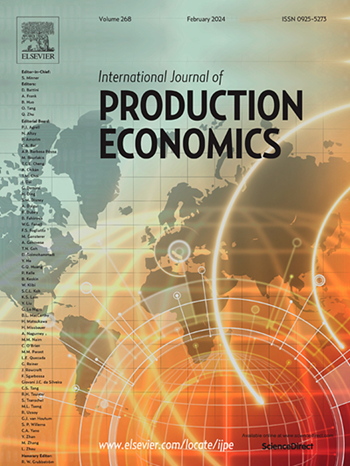Supply chain strategic behavior and coordination with a risk-averse manufacturer under random yield and demand
IF 9.8
1区 工程技术
Q1 ENGINEERING, INDUSTRIAL
引用次数: 0
Abstract
Random yield and demand (dual random) have been long plaguing the operational decisions of supply chain enterprises. In this paper, we introduce a comprehensive supply chain model characterized by a risk-averse manufacturer and a risk-neutral distributor, with the latter providing a credit guarantee to secure financing for the former. Employing the conditional value-at-risk (CVaR) criterion, we conduct a thorough analysis of the strategic dynamics inherent in the dual random supply chain, yielding key findings. Firstly, our investigation begins by defining a risk-dominant yield rate, from which we derive a risk-averse level-dependent safety purchasing threshold. We find that the distributor’s purchasing decision at this threshold depends on a comparative assessment of revenue and risk, which is primarily influenced by the manufacturer’s risk attitude and the guarantee coefficient. Secondly, we discover that the production strategies of manufacturers are predominantly influenced by yield risk if the distributor’s actual purchasing quantity falls below the threshold, leading to the maintenance of a safety production quantity. Conversely, when the purchasing quantity surpasses the threshold, the distributor’s behavior becomes the focal point, prompting the manufacturer to expand production. Lastly, we identify that the credit guarantee plays a significant role in operational decisions only when the distributor’s orders exceed the safety purchasing threshold and the manufacturer exhibits a high risk tolerance. Under these circumstances, we design the credit guarantee contract to facilitate supply chain coordination, mitigating the double marginal effect and enhancing overall supply chain efficiency.
求助全文
约1分钟内获得全文
求助全文
来源期刊
CiteScore
21.40
自引率
7.50%
发文量
266
审稿时长
52 days
期刊介绍:
The International Journal of Production Economics focuses on the interface between engineering and management. It covers all aspects of manufacturing and process industries, as well as production in general. The journal is interdisciplinary, considering activities throughout the product life cycle and material flow cycle. It aims to disseminate knowledge for improving industrial practice and strengthening the theoretical base for decision making. The journal serves as a forum for exchanging ideas and presenting new developments in theory and application, combining academic standards with practical value for industrial applications.

 求助内容:
求助内容: 应助结果提醒方式:
应助结果提醒方式:


